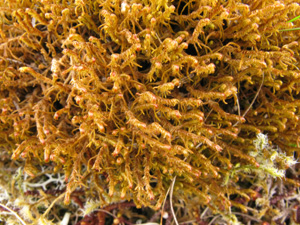DNA Barcoding Of Liverworts - A Powerful Tool In Species Discovery
Published on 27 April 2010 in Sustainability and Communities , Ecosystems and biodiversity
Introduction
DNA barcoding is an actively developing field of natural history science. The long-term goal is to develop a universal genetic system to help with the rapid identification of samples of known species, and to contribute towards discovery of new species. The principle is to choose a standard short region of DNA and produce an open-access centralised database of sequences (‘barcodes’) which can be used as a reference library against which unknown samples can be compared. In animals, DNA barcoding has already proved useful and relatively straightforward, using the mitochondrial gene CO1. In plants, however, finding a ‘standard DNA barcoding region’ has been more difficult. The chloroplast regions matK and rbcL have now been adopted internationally as preferred regions, but in some cases supplementary regions such as ITS are also needed.
As part of a trialling study at RBGE on barcoding different plant groups, we found that it works extremely well in bryophytes (over 90% discrimination of species). As a pilot study we therefore chose British liverworts as a reasonably-sized sample group (400 species) and, using a network of volunteers from the British Bryological Society, we have collected around half the samples needed to cover 90% of the species.
Britain has an extremely rich bryophyte flora (around 6% of global species) which have an important ecological role in many ecosystems. However, they are relatively poor in distinctive characters and often hard to distinguish and identify, which makes them ideal for barcoding - which we expect may reveal widespread ‘cryptic speciation’ particularly in liverworts.
Key Points
The basic principle of DNA barcoding is that individuals within a given species will be more genetically similar to each other, than to members of other species. The major task is to construct a database of sequences of known species. This involves field collection and recording of data (or in cases of great rarity using existing dried herbarium specimens). Essential at this stage is specimen purity, correct identification and preservation of voucher material. DNA is extracted from these ‘standard’ samples and sequenced for the preferred regions.
These sequences are databased and become the standards against which further samples can be tested. In some cases more than one distinct sequence may be found under one name, suggesting that cryptic speciation may be involved. Further sampling will then be needed to shed light on the problem, along with careful microscopic study of the samples to look for features which might distinguish the genetic species. In other cases where more than one species has an identical barcode, further regions will be sequenced to establish whether the species are genetically identical and therefore not distinct.
Research Undertaken
The leafy liverwort genus Herbertus (‘Prongworts’) was chosen for study using DNA barcoding to investigate the status of the four known European species, three of which grow in Scotland. It included the very rare Herbertus borealis (Northern Prongwort) known only from one area in Scotland (Beinn Eighe National Nature Reserve) and one part of Norway (Lysefjord). Previous field work in both sites had aroused suspicions that they might not be identical but the apparent differences had been explained by ecological factors.
However, the barcoding results indicated convincingly that in Europe there are five (not four) distinct species of Herbertus, and that plants previously identified as H. borealis from Beinn Eighe are a distinct species from Norwegian samples.

Image: Herbertus borealis on Beinn Eighe
Furthermore, a population from Ronas Hill, Shetland proved to match the Norwegian samples in its DNA barcode. Attempts to find a name for the Norwegian/ Shetland plant failed and it will be described as a species new to science in the near future. Comparison of herbarium specimens has revealed some previously overlooked morphological differences, so that this species can now be recognised in the field as well as the laboratory. However, DNA barcoding provided the crucial breakthrough in establishing their true identities.
.jpg)
Image: New Herbertus species on Ronas Hill, Shetland
This study is being repeated for almost all the British liverworts, and already there are signs that the same situation could apply elsewhere; for example in the thalloid liverwort Aneura pinguis (Greasewort) several species exist which as yet have no botanical name. The ongoing challenge is to find morphological differences to facilitate recognition of these in the field.
Policy Implications
This research brings a new powerful tool to taxonomic science, which can clarify issues of taxonomic uncertainty in our flora. This is particularly relevant in conservation of rare species, where taxonomic certainty is essential to ensure that distinct endangered species yet with subtle distinguishing characters receive appropriate conservation action and avoid expending resources or effort in conservation action on dubious ‘species’ that turn out not to be distinct.
The potential now exists for application of these methods to a range of rare plants in Scotland where resources could be more effectively managed to maximise benefits to conservation efforts, and avoid unnecessary expenditure.
DNA barcoding, because it works rapidly and with tiny fragments of plant material, has great potential in many areas of Scotland’s economy, such as identifying and patenting plant varieties, identifying imported plants, forensic identification of plant products, identification of fungi involved in poisoning, etc.
Author
Dr David Long, Royal Botanic Garden Edinburgh. d.long@rbge.ac.uk
Topics
Sustainability and Communities , Ecosystems and biodiversity







